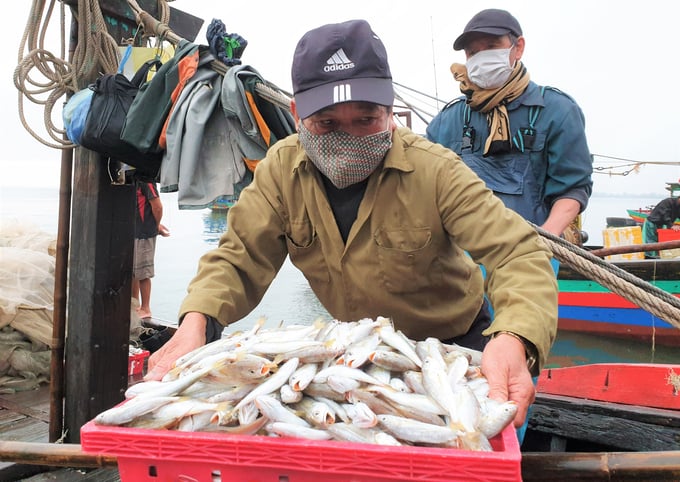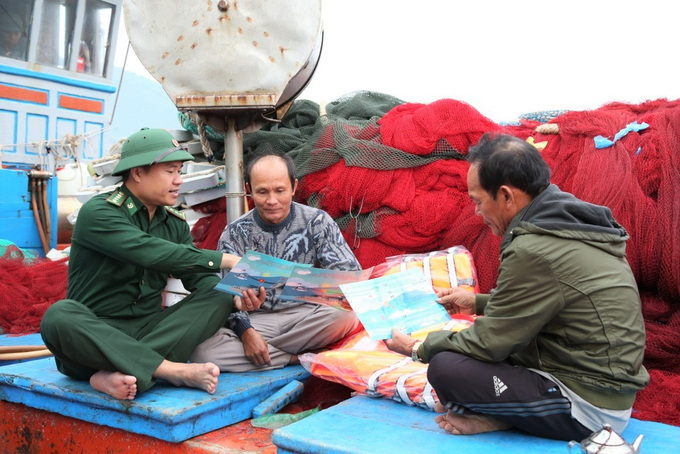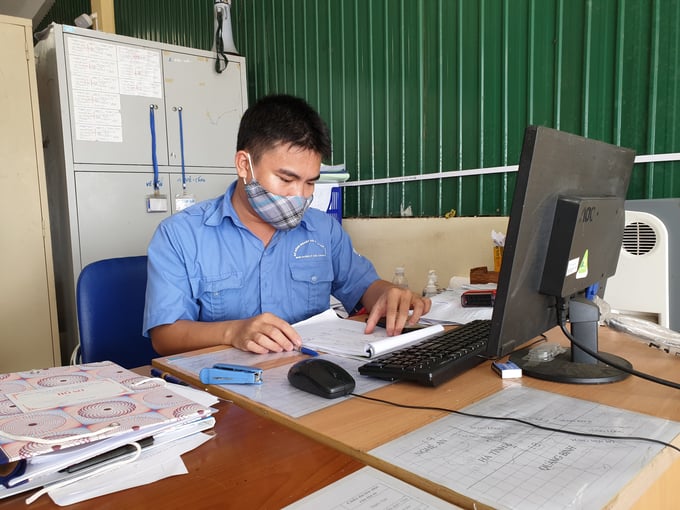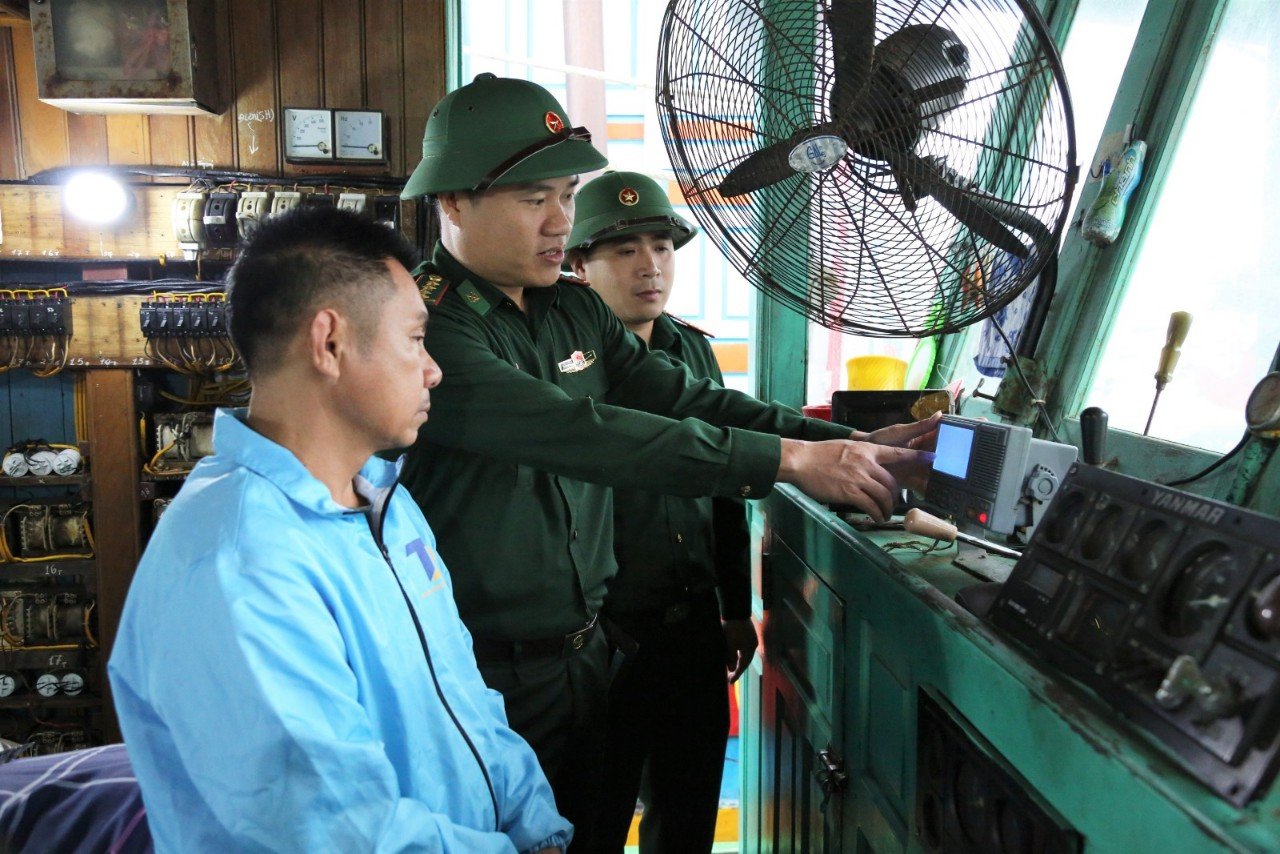November 28, 2025 | 03:37 GMT +7
November 28, 2025 | 03:37 GMT +7
Hotline: 0913.378.918
November 28, 2025 | 03:37 GMT +7
Hotline: 0913.378.918
As a North Central Coast province with a 137 km coastline, over 20 large and small rivers flowing into 4 estuaries, Ha Tinh is a locality with a lot of potential for fisheries development.
The province currently has 2,957 registered fishing vessels, of which 617 ships (12 m long or more) operate on high seas. They are also the group that contributes most of the province's fishing output and value. The rest of the fishing vessels account for more than 80% of coastal marine activities.

Declared fishing in accordance with the Law on Fisheries is the only way to remove the IUU yellow card. Photo: Thanh Nga.
Mr. Le Duc Nhan, Deputy Director of Ha Tinh Department of Agriculture and Rural Development, said, “There is still much work to be done, but it’s true that the fishing process at sea of Ha Tinh fishermen has made many positive changes. First of all, no fishing vessels violate the fishing grounds of foreign waters. Co-management coastal fisheries groups are formed, attracting the participation of a large number of fishermen. This movement has created the core force that coordinates with functional agencies to ensure security at sea and prevent ships from using explosives and other banned fishing gear”.

The Cua Sot border guard force disseminating regulations against IUU fishing to local fishermen. Photo: Thanh Nga.
After many efforts, by the beginning of 2023, the whole province of Ha Tinh has completed registration in the national fishing vessel database for 2,957 fishing vessels, including 2,340 units (79.1%) from the largest group, which are fishing vessels of 6 to less than 12 m long, 510 units (17.3%) from the group of fishing vessels with the length from 12 to under 15 m, and 107 units (3.6%) from the group of fishing vessels with the length from 15m or more.
There are 2,898/2,957 fishing vessels that perform marking and draw number plates in accordance with regulations, reaching over 98%; 2,957/2,957 fishing vessels have been granted fishing licenses, reaching 100%, of which 2,415/2,957 (81.67%) still have valid licenses. As for the installation of cruise monitoring equipment, there are currently 6 fishing vessels not installed due to damage. These fishing vessels stay on the shore and do not engage in fishing activities at sea.

Fishermen’s output can be traced through the supervision of Cua Sot Port Representative Office of Fisheries Inspection and Control. Photo: Thanh Nga.
“Changes in awareness, as well as changes in the compliance of fishermen with the Law on Fisheries, is worthy of praise, but it is not enough to meet the strict requirements of the European Commission in combating IUU fishing. Just take a look at the fishing log recording alone, fishermen have actively recorded and submitted fishing logs and reports, but due to some fishermen’s limited ability, the information recorded in the fishing log is still incorrect,” said Mr. Le Duc Nhan.
After more than 5 years of being warned by the EC, the Government, central ministries and local authorities have taken drastic actions, but so far we have not been able to remove the ‘yellow card’ and are even in danger of getting a “red card”. Therefore, the task against IUU fishing this time is of utmost urgency and importance as it not only affects the livelihood of fishermen but also the reputation of Vietnam in the world.

Ha Tinh fishermen mainly have small ships fishing inshore, so controlling 100% of ships entering and leaving the wharf at the border posts poses certain difficulties. Photo: Thanh Nga.
In the event of a ‘red card’ being drawn, Vietnam's seafood would totally ‘freeze’. And not only the European market, the risk of other continents turning away from Vietnamese seafood is also very high. Localities conducting direct exports of fishery products will suffer the damage firsthand, then comes the stagnation in the fishing activity of millions of fishermen, the depletion of aquatic resources and the recession, exploited products unable to consume, and unstable prices.
“Ha Tinh fishermen mainly have small ships fishing inshore, leaving in the morning and coming back in the evening, so it is actually very difficult to ensure that 100% of the ships entering and leaving the wharf are controlled at border posts and stations. It’s hard, but it must be done. In the immediate future, we will focus on propagating through a variety of methods so that fishermen can proactively declare information, applying sanctions comes after,” said Mr. Nguyen Cong Hoang, Director of Ha Tinh Sub-Department of Fisheries.
Translated by Samuel Pham

(VAN) According to Mr. Vo Minh Thanh, Director of the Tay Ninh Department of Agriculture and Environment, Resolution 57 has created a new development pathway for the locality, shifting from traditional toward modern agriculture.
/2025/11/26/4909-2-154329_878.jpg)
(VAN) Pearl grouper farming in HDPE cages not only delivers economic efficiency but also contributes to protecting the environment, creating jobs, and promoting marine-based experiential tourism.

(VAN) The model of making a living under the forest canopy through the agroforestry system in Van Son commune, Bac Ninh province, is expected to generate an annual income of approximately VND 30 million/ha.

(VAN) Many enterprises in Can Tho are harnessing natural energy and reducing greenhouse gas emissions in their production processes, thereby contributing to the promotion of a sustainable green transition.
/2025/11/24/3536-2-112800_176.jpg)
(VAN) Dong Nai now has tens of thousands of hectares of forests certified for sustainable management, and this area will continue to be expanded in the coming period.

(VAN) Vinh Ha hamlet (Dai Xuyen commune, Hanoi) is shifting away from small-scale farming as households adopt bioscurity into their breeder chicken models.

(VAN) Heavy rains make aquatic species more vulnerable to disease. Proactive water management and high-tech systems help farmers prevent outbreaks and protect yields.